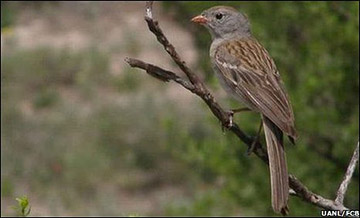
|  |  |  Editorials | Environmental Editorials | Environmental  
Rare Worthen's Sparrow Nest Sites Found in Mexico
 Matt Walker - BBC Earth News Matt Walker - BBC Earth News
go to original
March 22, 2010


| A male sparrow searches for a mate.

SPARROW SPOTTING: Worthen's sparrow stands just 13cm tall on average and is identifiable by its distinctive head pattern, sporting a grey head with a rufous crown, brown stripe and pink beak.

Overall it is similar in appearance to the far more common field sparrow, though it has a unique plumage and song, a dry chipping trill that last two to three seconds.

The species nests from May to July, usually laying three to four eggs. |  |
Three new breeding sites of one of the world's rarest birds, the Worthen's sparrow of Mexico, have been found.

The discovery of nests in the states of Nuevo Leon and Coahuila confirms the bird needs desert scrub to breed.

Such information may help conservationists formulate a plan to save the species from extinction.

Just a few hundred Worthen's sparrows survive, and until the latest discovery little was known about where and how the bird reproduces.

Details of the new breeding locations are published in the Journal of Field Ornithology.

Worthen's sparrow (Spizella wortheni) was originally discovered in the United States, where just a single bird was caught on 16 June 1884, near Silver City, New Mexico.

No Worthen's sparrows have since been captured in the country, where it is now thought to be extinct.

Formally, the bird also ranged over much of the Mexican Plateau.

However, now it is found in just a handful of places in northeastern Mexico, says Dr Ricardo Canales-del Castillo of the Universidad Autonoma de Nuevo Leon in San Nicolas de los Garza, Mexico.

That makes it one of the rarest sparrows in North America.

What is more, although flocks of the sparrow are sometimes seen in winter, little is known about where the bird lives and breeds in the summer, information that is crucial to safeguarding the species's future.

Caught in the act

So Dr Castillo and colleagues decided to search out places where the sparrow might be hiding.

This was particularly difficult because of the sparrow's behaviour: Worthen's sparrows do not migrate, but they move on from nesting sites as soon as the breeding season ends.

So the researchers had to catch the birds in the act of egg-laying and rearing.

Over the past 30 years, the sparrows have only been seen in a 25km squared area in northeastern Mexico, with most of its historical breeding sites since converted to agriculture.

These historical records also suggested the sparrows like to breed in valleys full of desert scrub and grassland, habitat also filled by prairie dogs.

So Dr Castillo's team targeted areas of similar habitat, particularly searching around the La Soledad valley in the municipality of Galeana, home to one of Mexico's most important prairie dog locations.

They found nests at San Rafael in Galeana, Nuevo Leon and at La Carbonera in the same state.

Another nests were also found at San Jose del Alamito just over the border into the state of Coahuila, but still within the La Soledad valley.

Overall, the researchers recorded 51 individual sparrows, which is half the 100 to 120 individuals that survive in the wild, according to the latest data held by the International Union for the Conservation of Nature (IUCN).

"Our most optimistic estimate is that 500 individuals remain," Dr Castillo told the BBC.

Knowing where the sparrow breeds could help protect it in the future, as conservationists can now attempt to preserve grasslands and associated shrubby areas, he says.

One such project under way, coordinated by the Bird Conservation Alliance, is seeking to purchase prime grassland habitat in the Saltillo Savannah in Mexico, which will also help preserve habitat vital for other species such as long-billed curlews, burrowing owls, mountain plovers, Sprague's pipits and Ferruginous hawks. |

 |
|  |



